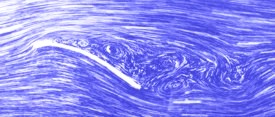We can see the role played by friction drag (sometimes called viscous drag) and pressure drag (sometimes called form drag or profile drag) by considering an airfoil at different angles of attack.
At small angles of attack, the boundary layers on the top and bottom surface experience only mild pressure gradients, and they remain attached along almost the entire chord length. The wake is very small, and the drag is dominated by the viscous friction inside the boundary layers. However, as the angle of attack increases, the pressure gradients on the airfoil increase in magnitude. In particular, the adverse pressure gradient on the top rear portion of the airfoil may become sufficiently strong to produce a separated flow. This separation will increase the size of the wake, and the pressure losses in the wake due to eddy formation Therefore the pressure drag increases. At a higher angle of attack, a large fraction of the flow over the top surface of the airfoil may be separated, and the airfoil is said to be stalled. At this stage, the pressure drag is much greater than the viscous drag, and it acts like a bluff body
.
 |
 |
Figure 14.1 Separated flow over a thin airfoil. |

